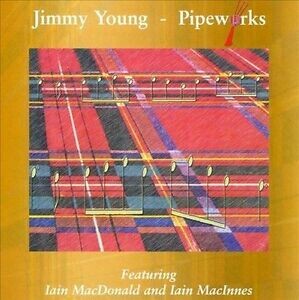 Patrick O’Donnell wrote this review.
Patrick O’Donnell wrote this review.
There probably is no sound more associated with Celtic music than that of the pipes. They’re heard at almost every Celtic festival, on St. Patrick’s Day, and in movie soundtracks ranging from “Rob Roy” and “Braveheart” to “Titanic.” What most people don’t realize, however, is that there’s more than just the Highland variety bagpipe they see being played by the man in the funny plaid skirt.
One listen to Scottish native Jimmy Young’s Pipeworks would dispel that notion.
Young, founder of the New Zealand group Rua, uses the album as a conduit to deliver different types of bagpipes — the Scottish smallpipes, Northumbrian pipes and border pipes — and blends them with the mandolin, fiddle, viola, hurdy gurdy, mandola, and cello.
The Northumbrian pipes, according to the Northumbrian Smallpipes Encylopaedia, take their name from Northumberland, England, a county on the Scottish border. They’re a small, subtle, quiet keyed instrument. The musician plays by inflating a bellows with his or her arm. Scottish smallpipes, also a bellows-type instrument, are sort of a quieter, indoor version of the familiar Great Highland Bagpipe (played by blowing air into a bag, which is then squeezed). Border pipes, according to the site, are the same as Northumbrian half-longs: a larger, louder version of the subtle Northumbrian smallpipes.
But this album does more than bring together different types of bagpipes. It also doubles as a tribute to Greenpeace’s first “Rainbow Warrior,” which was scuttled by members of the French Secret Service. The seven tracks dedicated to the ship begin before the vessel was christened and end with its 1985 sinking in Auckland Harbor, New Zealand, apparently a move to keep Greenpeace from interfering with France’s nuclear tests. As such, Pipeworks is at once celebratory and melancholy; from the joyous blend of piping on “Warrior’s Reel” to the mournful marriage of cello and Northumbrian pipes on “Exodus”; from the elation of its first run under full canvas in “Full-Rigged” to the funeral dirge of “End of the Rainbow” as the Warrior slips beneath the waves, bombs having claimed the ship and photographer Fernando Pereira.
This 11-track disc, recorded in Edinburgh, is a welcome diversion any day of the week and works equally well as background filler or contemplative music. Young’s playing is sharp and his style is distinctive; on “Sir William Hardie’s Waltzruka,” for instance, his fingers practically fly over the keys, though each note is crisp, each nuance clear. The tune, a mixture of a waltz and a mazurka, is one of the disc’s many forays into “world” music.
The introduction of non-traditional instrumentation and styles has been a trend in contemporary Celtic music for quite some time. It’s a tactic that can be overdone, and often is. Sometimes it’s done so poorly that the mix of instrumentation and styles is jarring, the end result sounding like the cacophony of a middle-school band warming up. Not so with Young, who excels at this task; he blends just the right amount of traditional Celtic with other instrumentation, building multiple layers of sound that fit seamlessly together on a foundation that’s cemented firmly in the traditional.
Young, a musician and composer for the last 20 years, also plays whistles and percussion, and is a renowned flutist (a sound sadly absent from this album because, he notes in the liner, his prize flute was stolen from London’s Royal Oak Pub).
He sets sail with the best of company for his Pipeworks voyage: Iain MacDonald of the Battlefield Band on Scottish smallpipes; Iain MacInnes of Smalltalk on border pipes; Chic MacAulay on guitar; Ron Shaw on cello; Iain MacLeod of Shooglenifty, formerly of Rua and the House Band on 10-string mandolin; John Martin of the Tannahill Weavers and The Easy Club on fiddle; Davy Stuart on viola, hurdy gurdy and mandola; Rua’s Jon Hooker on guitar; fellow Rua member James Wilkinson on fretless bass; Fergus MacKenzie on djembe and shakers; and James MacKintosh of Shooglenifty on bongos.
Denny Stanway’s gentle voice is beautiful and light on “Who Knows Where the Time Goes,” and Billy Ross’s Gaelic strong and clear on the traditional “The Braes, The Braes.” These are the only tracks on Pipeworks to feature vocals.
Pipeworks is an exceptional album, a step above the rest. It’s moving, well thought out, and beautifully arranged. It’s a must for any proper Celtic collection.
(Greentrax, 1999)
For more information on pipes and piping, visit the Northumbrian Smallpipes Encyclopaedia and The Universe of Bagpipes.
